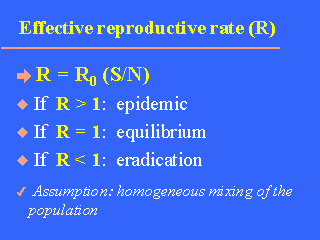| front |1 |2 |3 |4 |5 |6 |7 |8 |9 |10 |11 |12 |13 |14 |15 |16 |17 |18 |19 |20 |21 |22 |23 |24 |25 |26 |27 |28 |29 |review |
 |
In real life,
populations are not "totally susceptible"; usually immune individuals are also
around. Therefore, an infection is actually reproduced at a rate which is equal to the basic reproductive rate reduced by the fraction of susceptibles in the host population. This is called "effective" or "actual" reproductive rate (symbol R). This can be expressed as: R = R0 (S/N), where S is the number of susceptibles and N the total population. It is clear that: - if R>1, in the next time period of the spread of the infection, there will be more than one new case per infected person, and therefore (if this continues) there will be an epidemic, - if R=1, in the next time period, there will be one new case per infected person, which is a state of equilibrium (the disease is endemic), - if R<1, in the next time period, there will be less than one new case per infected person, and eventually (if R continues to be <1) the microorganism will disappear. Note that the above assume homogeneous mixing of the population (i.e. everyone in the population has the same chance to meet everyone else). |